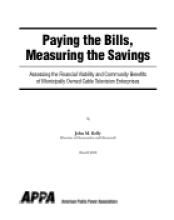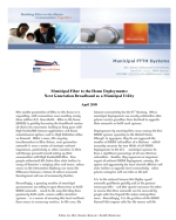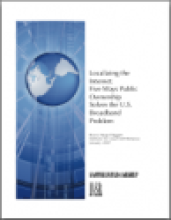
Fast, affordable Internet access for all.

As promised a few weeks ago, Ellen Perlman has written a piece on the story behind the Lafayette, Louisiana publicly owned FTTH network. This might just be the best network available in the U.S. in terms of offering the fastest speeds at the more affordable prices and offering the most benefit to the community. The path was certainly not easy nor quick but they are now offering services. The video below is a good example of how communities can respond to incumbents that prefer to advertise and lie rather than invest in networks. Fortunately the folks down in Louisiana didn't take Slick Sam lying down - they confronted him and are building a modern network to ensure Lafayette can flourish in the future. They no longer have to beg absentee-run networks for upgrades.
The problem, as city and county broadband planners see it, has less to do with technology than with the sheer legwork required to create an acceptable proposal. Applicants must prove that all the areas they propose to serve would meet a narrow federal definition of being underserved -- that 50 percent or more households in the area lack broadband access, or that fewer than 40 percent of the households already subscribe to broadband. That puts the burden on cities and counties to undertake expensive and time-consuming door-to-door surveys, because telephone and cable companies don't reveal which areas they serve.In the meantime, private companies like Qwest are not even sure they will participate as they do not like the requirements that grantees operate the network without discriminating against some kinds of content (meaning they want to charge more to visit some sites than others). Though Qwest has not been as bullish on this money-making idea as AT&T, one assumes it is not too far off. Telephony's Ed Gubbins also comments on the many municipalities that have little hope of grants under NTIA's rules:
One group of broadband stimulus hopefuls that has been in large part swept out of the running by the specifics of the plan is individual municipalities of any size.
Geoff Daily, from App-Rising.com, and I recently did a vidchat about muninetworks.org and its purpose. App-Rising.com pulled some key points from it, but you can view the entire 9 minute segment below.

Cedar Falls Utilities, the largest municipally owned four-service utility in Iowa, provides electric, natural gas, water and communications services to a community of over 36,000 people. The citizens of Cedar Falls have been and continue to be the driving force behind Cedar Falls Utilities. Because of citizen demand and involvement, what once began as an unreliable water supply from “Big Springs,” a small light plant built with discarded bricks and an outdated manufactured gas system, has grown into an organization that is recognized nation-wide in the utility industry for outstanding performance management and some of the most favorable utility rates in the country. Cedar Falls Utilities (CFU) is a strong supporter of economic development. Through the years, the Cedar Falls community has directly benefited by the operation of its municipally owned utilities through direct customer rate savings, free or special customer service programs and fund transfers to the City’s general fund. CFU has made great strides to further its commitment to economic development. In 1994, a new horizon was encouraged through visionary thinking. Considerable strategic planning and analysis preceded the decision to design, construct and operate a Broadband Fiber Optic Communications System. The Cedar Falls Board of Trustees spent approximately 24 months studying the technical and financial feasibility of constructing and operating such a network. Finally, on October 24, 1994, the Cedar Falls City Council adopted ordinance No. 2072 forming the country’s second Municipal Communications Utility and transferring authority to the Cedar Falls Utilities Board of Trustees.
"There are two primary components to building this system. One component is taking longer than we thought and the other is happening much faster than we anticipated", said Harold DePriest, President and CEO. "The end result is that services will be available to the entire cities of Chattanooga, East Ridge and Red Bank by summer of 2010." DePriest says once in place, EPB's fiber optic network will be the largest of its kind in the country.However, Chattanooga has suffered the same problem that has plagued other publicly owned broadband projects around the country: incumbent telco and cableco lawyers. Comcast has sued Chattanooga in multiple courts in an attempt to limit competition (see here, here, here, and here for a few examples). As with these cases across the country (from Monticello, MN to Bristol, VA, to Lafayette, LA), the incumbents have lost the cases but successfully slowed the build-out, which hurts the community while padding company profits for an extra couple of years. The network will offer symmetrical speeds of 10-50Mbps while keeping costs lower than the standard prices in the market.
Salisbury, a city of nearly 30,000 in North Carolina, has started building its full fiber-to-the-home network. Salisbury had some difficulty in funding the network at first due to the collapsing economy last year. However, they securing financing in November 2008 and have now started building the network. A recent Salisbury Post article notes that Atlantic Engineering Group is installing conduit. However, residents will have to wait more than a year to take any services. They still have to build the multi-million dollar head end. They already have agreements covering access to the telephone polls -- which are owned by Duke Energy and AT&T.

This paper provides evidence that municipally owned and operated cable television enterprises are financially viable and provide large rate savings to their communities. The findings contradict allegations in Costs, Benefits, and Long-Term Sustainability of Municipal Cable Television Overbuilds, a 1998 paper authored by Ronald J. Rizzuto and Michael O. Wirth, that such enterprises are likely to be poor investments for cities. The authors claim that analysis of financial histories of the cable enterprises in Glasgow (Kentucky), Paragould (Arkansas), and Negaunee (Michigan) “clearly indicates that [they] have been poor investments from a pure business perspective.” They are pessimistic about the fourth, Cedar Falls (Iowa). The authors contend that these enterprises “have not generated [or will not generate] sufficient cash flows to cover their out of pocket cash needs.... None ... [is] currently sustainable over the long run.” However, by the incorrect criteria and analysis that Rizzuto and Wirth use, few new enterprises—public or private—would pass financial muster. The authors further contend that the only reason these utilities have been able to remain solvent is because of various subsidies, personal and property tax transfers, or interest-free loans. Rizzuto and Wirth’s conclusions are not surprising since their paper was partially funded by Telecommunications, Inc. (“TCI”), the private, incumbent cable television provider in Cedar Falls at the time the city was creating its municipal cable enterprise. Although Rizzuto and Wirth’s paper was published seven years ago, critical review of it is timely and important. Formation of municipal cable enterprises is a major public policy issue; private broadband providers have been successful in having several states bar or place crippling limitations on the formation of such enterprises. The time that has elapsed since the paper was published provides a good perspective for checking the authors’ predictions about the financial viability of the four municipal enterprises. Most importantly, however, Rizzuto and Wirth’s paper is often cited currently by those who oppose municipal entry in the cable television industry and related broadband industries. Their paper is widely quoted in reports of other organizations that oppose formation of municipal cable enterprises.

This report is basically a snapshot of how Community FTTH systems were doing as of early 2008. Deployments by municipalities were among the first FTTH systems operating in the United States. Though, in aggregate, they do not approach the number of FTTH subscribers of a Verizon – which currently accounts for two-thirds of all FTTH deployments in the U.S. – municipal systems do have a significant percentage of all non-Verizon subscribers. Further, they represent an important aspect of national FTTH deployment, namely, the option and opportunity for local elected officials and civic leaders to upgrade local connectivity - when private enterprise will not take on the job.
In the case of muni systems, which are not-for-profit enterprises, one measure of “success” is defined as the level of their “take rate” – that is, the percentage of potential subscribers who are offered the service that actually do subscribe. Nationwide, the take rates for retail municipal systems after one to four years of operation averages 54 percent. This is much higher than larger incumbent service provider take rates, and is also well above the typical FTTH business plan usually requiring a 30-40 percent take rate to “break even” with payback periods.
